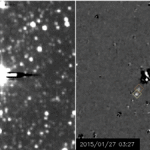Unusual Red Arcs Spotted on Saturn’s Moon Tethys
The red arcs are narrow, curved lines on the moon’s surface, and are among the most unusual color features on Saturn’s moons to be revealed by Cassini’s cameras.
Images taken using clear, green, infrared and ultraviolet spectral filters were combined to create the enhanced-color views, which highlight subtle color differences across the icy moon’s surface at wavelengths not visible to human eyes.
A few of the red arcs can be seen faintly in observations made earlier in the Cassini mission, which has been in orbit at Saturn since 2004. But the color images for this observation, obtained in April 2015, are the first to show large northern areas of Tethys under the illumination and viewing conditions necessary to see the arcs clearly. As the Saturn system moved into its northern hemisphere summer over the past few years, northern latitudes have become increasingly well illuminated. As a result, the arcs have become clearly visible for the first time.
Watch the Video to See Tethys Up Close:
“The red arcs really popped out when we saw the new images,” said Cassini participating scientist Paul Schenk of the Lunar and Planetary Institute in Houston. “It’s surprising how extensive these features are.”
The origin of the features and their reddish color is a mystery to Cassini scientists. Possibilities being studied include ideas that the reddish material is exposed ice with chemical impurities, or the result of outgassing from inside Tethys. They could also be associated with features like fractures that are below the resolution of the available images.
Except for a few small craters on Saturn’s moon Dione, reddish-tinted features are rare on other moons of Saturn. Many reddish features do occur, however, on the geologically young surface of Jupiter’s moon Europa.
“The red arcs must be geologically young because they cut across older features like impact craters, but we don’t know their age in years.” said Paul Helfenstein, a Cassini imaging scientist at Cornell University, Ithaca, New York, who helped plan the observations. “If the stain is only a thin, colored veneer on the icy soil, exposure to the space environment at Tethys’ surface might erase them on relatively short time scales.”
The Cassini team is currently planning follow-up observations of the features, at higher resolution, later this year.






